|
Multiple joint sets refer to more than one set of joints with noticeably different orientations (Figure 1), thus intersecting each other or more likely mutually abutting against each other at the same locality.
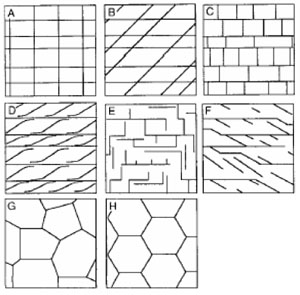 | | Figure 1. Schematic illustration of common multiple joint patterns. A. Orthogonal both continuous. B. Non-orthogonal continuous. C. Orthogonal, one continuous but the other discontinuous. D. Non-orthogonal, one continuous, the other discontinuous. E. Orthogonal, both sets being discontinuous. F. Non-orthogonal, both sets discontinuous. G. and H. columnar joints with triple intersections the latter of which has intersection angles of 120 degrees. From Pollard and Aydin (1988). |
Following Lachenbruch (1961), multiple joint sets are classified into two categories as orthogonal (Figures 1 A, C, E) and non-orthogonal (Figures 1 B, D, F). Figure 2 shows a field example of two sets of orthogonal joints on a sandstone pavement and Figure 3 shows two sets of non-orthogonal joints dividing the rock into diamond-shaped blocks.
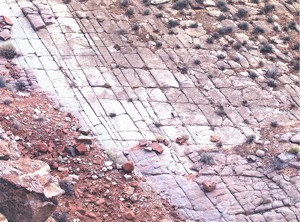 | | Figure 2. Orthogonal joints on a sandstone pavement. Photo from D. D. Pollard. For a map showing a similar pattern, see Olson and Pollard (1989). |
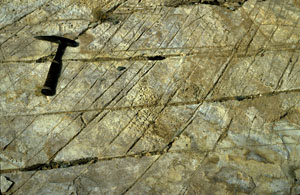 | | Figure 3. Photo showing two sets of non-orthogonal joints bounding diamond-shaped blocks in quartzite, Mosaic Canyon, Death Valley, NV. Both sets are partially filled by precipitants. The set paralleling the longer side of the photo is more continuous, while some of the diagonal fractures have truncated ends. The horizontal set is the earlier one and slightly sheared. However, in some other cases the diagonal fractures appear to cut across the older fractures. |
Figures 4 and 5 illustrate more complicated joint patterns consisting of three or more joint sets with various intersection angles. The photograph in Figure 6 shows an image of nested polygonal joint systems in sandstone bounding dome-shaped landforms. The origin of these multiple sets of joints is most likely of desiccation. In this regard, they are close relatives of columnar joints in volcanic rocks to be considered under 'Columnar Joints.'
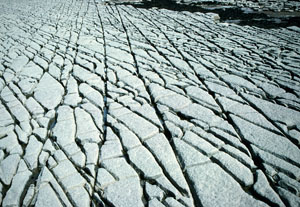 | | Figure 4. Photo showing three sets of joints in limestone, Bristol Channel, UK. The set oriented near vertical (N-S set in the middle) is the earliest set. The prominent diagonal set formed second as the joints of this set abut the oldest set. The third set is discontinuous, oriented perpendicular to and truncated against the second set and occasionally are at high angle to the oldest set. |
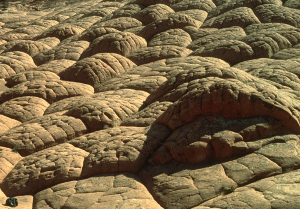 | | Figure 6. A spectacular image of dome-shaped landforms which are bounded by polygonal joints in the Navajo Sandstone exposed at the Buckskin Gulch across the southeastern Utah-northern Arizona border. The larger polygons have diameters of several meters and the smaller polygons within the large ones have diameters of tens of centimeters. Note a backpack and a hammer on the lower left corner for scale. |
| |
Aydin, A., DeGraff, J.M., 1988. Evolution of polygonal fracture patterns in lava flows. Science 239 (4839): 471-476.
Lachenbruch, A.H., 1961. Depth and spacing of tension cracks. Journal of Geophysical Research 66: 4273-4292.
Olson, J., Pollard, D.D., 1989. Inferring paleostresses from natural fracture patterns: A new method. Geology 17: 345-348.
Pollard, D.D., Aydin, A., 1988. Progress in understanding jointing over the past century. Geological Society of America Bulletin 100 (8): 1181-1204.
|




